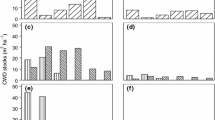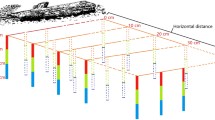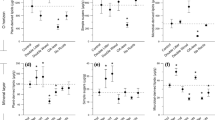Abstract
Coarse woody debris (CWD) may create a spatially discrete soil imprint through the release of carbon rich, acidic dissolved organic matter (DOM). DOM has been implicated in many soil processes such as humus formation, nutrient immobilization, podzolization, and the dissolution of soil minerals. We investigated a potential CWD imprint on soil chemistry by sampling leachates and soil solutions under CWD at different stages of decay and under the forest floor as controls. Solutions were analyzed for total dissolved organic carbon (DOC) and polyphenol concentrations. DOC was further separated by chemical fractionation. We also sampled soil from underneath CWD and from control areas without CWD. Samples were analyzed for pH, base saturation, exchangeable acidity, and several aluminum and iron fractions. The pH of CWD leachates was lower (p ≤ 0.001) and contained more polyphenols (p ≤ 0.0001) and DOC than control leachates, although chemical DOC fractions from CWD and the forest floor were similar. Surface mineral soils under CWD were lower in pH (p ≤ 0.005), had more exchangeable acidity (p ≤ 0.002) and more exchangeable aluminum (p ≤ 0.04) and iron (p ≤ 0.06) than forest floor soils. At depths greater than 5 cm, there were no differences between forest floor soils and soils under CWD. Our results suggest that CWD in the middle stages of decay acidifies the surface soil as it decomposes by decreasing exchangeable bases and increasing exchangeable acidity and aluminum. Soils under the most highly decayed CWD, or deeper soils were not affected by CWD. Although we hypothesized that well-decayed CWD would show a spatially explicit imprint on soils, the effect of CWD on soil chemistry was small and limited to surface mineral soils.
Similar content being viewed by others
References
Birkeland P.W. 1984. Soils and Geomorphology. Oxford University Press, Oxford.
Browne B.A. 1995. Toward a new theory of podzolization. In: McFee W.W. and Kelly J.M. (eds) Carbon Forms and Functions in Forest Soils. Soil Science Society of America, Inc., Madison, WI.
Busse M.D. 1994. Downed bole-wood decomposition in lodgepole pine forests of central Oregon. Soil Sci. Soc. Am. J. 581: 221–227.
Crampton C.B. 1982. Podzolization of soils under individual canopies in southwestern British Columbia, Canada. Geoderma 28: 57–61.
Cromack K. Jr., Sollins P., Graustein W.C., Speidel K., Todd A.W., Spycher G., Li C.Y. and Todd R.L. 1979. Calcium oxalate accumulation and soil weathering in mats of the hypogeous fungus Hysterangium crassum. Soil Biol. Biochem. 11: 463–468.
David M.B., Vance G.F. and Krzyszowska A.J. 1995. Carbon controls on spodosol nitrogen, sulfur, and phosphorus cycling. In: McFee W.W. and Kelly J.M. (eds) Carbon Forms and Functions in Forest Soils. Soil Science Society of America, Inc., Madison, WI, pp. 329–353.
Dixon J. and Noller J.S. 2002. How low can you go? Applying GIS to soil-landscape mapping at large scales. American Society for Agronomy Annual Meeting Abstracts, Indianapolis, IN.
Dutton M.V. and Evans C.S. 1996. Oxalate production by fungi: its role in pathogenicity and ecology in the soil environment. Can. J. Microbiol. 42: 881–895.
Fox T.R. 1995. The influence of low-molecular weight organic acids on properties and processes in forest soils. In: McFee W.W. and Kelly J.M. (eds) Carbon Forms and Functions in Forest Soils. Soil Science Society of America, Inc., Madison, WI, pp. 43–62.
Fox T.R. and Comerford N.B. 1990. Low-molecular-weight organic acids in selected forest soils of the southeastern USA. Soil Sci. Soc. Am. 54: 1139–1144.
Garner W. and Steinberger Y. 1989. A proposed mechanism for the formation of ‘ fertile islands’ in the desert ecosystem. J. Arid Environ. 16: 257–262.
Harmon M.E. and Lajtha K. 1999. Analysis of detritus and organic horizons for mineral and organic constituents. In: Robertson G.P., Coleman D.C., Bledsoe C.S. and Sollins P. (eds) Standard Soil Methods for Long-term Ecological Research. Oxford University Press, San Diego, pp. 143–165.
Harmon M.E., Franklin J.F., Swanson F.J., Sollins P., Gregory S.V., Lattin J.D., Anderson N.H., Cline S.P., Aumen N.G., Sedell J.R., Lienkaemper G.W., Cromack K. Jr. and Cummins K.W. 1986. Ecology of coarse woody debris in temperate ecosystems. Adv. Ecol. Res. 15: 133–302.
Hendershot W.H., Lalande H. and Duquette M. 1993. Soil reaction and exchangeable acidity. In: Carter M.R. (ed) Soil Sampling and Methods of Analysis. Canadian Society of Soil Science, pp. 141-146.
Jones D.L. 1998. Organic acids in the rhizosphere — a critical review. Plant Soil 205: 25–44.
Kaiser K. and Zech W. 1996. Nitrate, sulfate, and biphosphate retention in acid forest soils affected by natural dissolved organic carbon. J. Environ. Qual. 25: 1325–1331.
Kaiser K., Haumaier L. and Zech W. 2000. The sorption of organic matter in soils affected by the nature of soil carbon. Soil Sci. 165: 305–313.
Kayahara G.J., Klinka K. and Lavkulich L.M. 1996. Effects of decaying wood on eluviation, podzolization, acidification, and nutrition in soils with different moisture regimes. Environ. Monit. Assess. 39: 485–492.
Krzyszowska-Waitkus A., Vance G.F. and Preston C.M. Influence of coarse woody debris on soil organic matter in a Rocky Mountain Coniferous forest. Soil Sci. Soc. Am. J. (in review)
Lajtha K. and Schlesinger W.H. 1988. The biogeochemistry of phosphorus cycling and phosphorus availability along a desert soil chronosequence. Ecology 69: 24–39.
Lajtha K., Sollins P., Ellis B.G. and Robertson G.P. 1999. In: Robertson G.P., Coleman D.C., Bledsoe C.S. and Sollins P. (eds) Standard Soil Methods for Long-term Ecological Research. Oxford University Press, San Diego, pp. 106-114.
Lundstrom U., van Breemen N. and Bain D. 2000. The podzolization process. A review. Geoderma 94: 91–107.
Prescott C.P., Sollins P. and Sayer B.G. 1990. Changes in organic components for fallen logs in old-growth Douglas-fir forests monitored by 13C nuclear magnetic resonance spectroscopy. Can. J. For. Res. 20: 1382–1391.
Qualls R.G. 2000. Comparison of the behavior of soluble organic and inorganic nutrients in forest soils. Forest Ecol. Manage. 138: 29–50.
Qualls R.G. and Haines B.L. 1991. Geochemistry of dissolved organic nutrients in water percolating through a forest ecosystem. Soil Sci. Am. J. 55: 112–1123.
Qualls R.G., Haines B.L. and Swank W.T. 1991. Fluxes of dissolved organic nutrients and humic substances in a deciduous forest. Ecology 72: 254–266.
Ross G.J. and Wang C. 1993. Extractable Al, Fe, Mn, and Si. In: Carter M.R. (ed) Soil Sampling and Methods of Analysis. Canadian Society of Soil Science, pp. 239-246.
Schlesinger W.T., Raikes J.A., Hartley A.E. and Cross A.F. 1996. On the spatial pattern of soil nutrients in desert ecosystems. Ecology 77: 364–374.
Sollins P., Cline S.P., Verhoeven T., Sachs D. and Spycher G. 1987. Patterns of log decay in old-growth Douglas-fir forests. Can. J. For. Res. 17: 1585–1595.
Spears J.D.H., Holub S.M., Harmon M.E. and Lajtha K. The influence of decomposing logs on soil biology and nutrient cycling in an old-growth mixed coniferous forest in Oregon USA. Can. J. For. Res.in-press
Stevenson F.J. 1994. Humus Chemistry: Genesis, Composition, Reactions. JohnWisley & Sons, New York.
Tan K.H. 1986. Degradation of Soil Minerals by Organic Acids. Interactions of Soil Minerals with Natural Organics and Microbes. S.S.P. No. 17. Madison, WI.
Tani M. and Higashi T. 1999. Vertical distribution of low molecular weight aliphatic carboxylic acids in some forest soils of Japan. Eur. J. Soil Sci. 50: 217–226.
Triska F.J. and Cromack K. Jr. 1979. The role of wood debris in forests and streams. In: Waring R.H. (ed) Forests: Fresh Perspectives from Ecosystem Analysis. Oregon State University Press, Corvallis, pp. 171–190.
Yano Y., Lajtha K., Sollins P. and Caldwell B.A. Controls and dynamics of dissolved organic matter in a temperate coniferous forest on Andic soils: effects of litter quality. Ecosystems (in review)
Yavitt J.B. and Fahey T.J. 1985. Chemical composition of interstitial water in decaying lodgepole pine bole wood. Can J. For Res. 15: 1149–1153.
Author information
Authors and Affiliations
Corresponding author
Rights and permissions
About this article
Cite this article
Spears, J., Lajtha, K. The imprint of coarse woody debris on soil chemistry in the Western Oregon Cascades. Biogeochemistry 71, 163–175 (2005). https://doi.org/10.1007/s10533-005-6395-1
Received:
Accepted:
Issue Date:
DOI: https://doi.org/10.1007/s10533-005-6395-1




